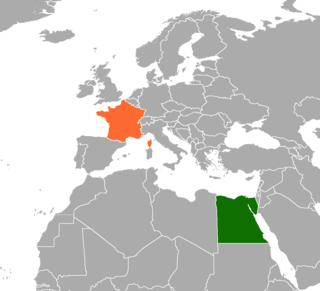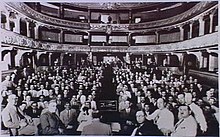
The Treaty of Amiens temporarily ended hostilities between France, the Spanish Empire, and the United Kingdom at the end of the War of the Second Coalition. It marked the end of the French Revolutionary Wars; after a short peace it set the stage for the Napoleonic Wars. Britain gave up most of its recent conquests; France was to evacuate Naples and Egypt. Britain retained Ceylon and Trinidad.

Port Said is a city that lies in northeast Egypt extending about 30 km (19 mi) along the coast of the Mediterranean Sea, straddling the west bank of the northern mouth of the Suez Canal. It forms the majority of the Port Said governorate, where its seven districts comprise seven of the governorate's eight regions. The city was established in 1859 during the building of the Suez Canal, and at the beginning of 2023 had a population of 680,375 people.

Ferdinand Marie, Comte de Lesseps was a French diplomat and later developer of the Suez Canal, which in 1869 joined the Mediterranean and Red Seas, substantially reducing sailing distances and times between Europe and East Asia.

The ʻUrabi revolt, also known as the ʻUrabi Revolution, was a nationalist uprising in Khedivate of Egypt from 1879 to 1882. It was led by and named for Colonel Ahmed Urabi and sought to depose the khedive, Tewfik Pasha, and end Imperial British and French influence over the country.

Isma'il Pasha, also known as 'Ismail the Magnificent, was the Khedive of Egypt and ruler of Sudan from 1863 to 1879, when he was removed at the behest of Great Britain and France. Sharing the ambitious outlook of his grandfather, Muhammad Ali Pasha, he greatly modernized Egypt and Sudan during his reign, investing heavily in industrial and economic development, urbanization, and the expansion of the country's boundaries in Africa.
1798 was a relatively quiet period in the French Revolutionary Wars. The major continental powers in the First coalition had made peace with France, leaving France dominant in Europe with only a slow naval war with Great Britain to worry about. The leaders of the Directory in Paris feared Napoleon Bonaparte's popularity after his victories in Italy, so they were relieved when he proposed to depart France and mount an expedition to Egypt to gain further glory.

Independence Day is one of the five national holidays in Malta. It celebrates the day the country gained independence from the United Kingdom on 21 September 1964. Throughout its existence, Malta had a long and complex history which resulted in the island being ruled by a plethora of foreign rulers. Such rulers include the likes of the “Phoenicians, Romans, Greeks, Arabs, Normans, Sicilians, Swabians, Aragonese, Hospitallers, French, and British”. Malta's final ruler, Britain, granted Malta self-governance after Malta's brave resistance to the Axis powers and loyalty to Britain during World War II, which did allow for the movement for independence to grow more in popularity. Malta attained independence from the British Empire and joined the Commonwealth of Nations in 1964 and declared itself a republic a decade later, known as Republic Day.

The Maltese people are an ethnic group native to Malta who speak Maltese, a Semitic language and share a common culture and Maltese history. Malta, an island country in the Mediterranean Sea, is an archipelago that also includes an island of the same name together with the islands of Gozo and Comino ; people of Gozo, Gozitans are considered a subgroup of the Maltese.

The French campaign in Egypt and Syria (1798–1801) was a Napoleonic campaign in the Ottoman territories of Egypt and Syria, executed by Napoleon Bonaparte. Napoleon proclaimed to "defend French trade interests" and to establish "scientific enterprise" in the region. It was the primary purpose of the Mediterranean campaign of 1798, which was a series of naval engagements that included the capture of Malta and the Greek island Crete, later arriving in the Port of Alexandria. The campaign ended in defeat for Napoleon after abandoning his troops to head back to France for the looming risk of a Second Coalition. This led to the death and withdrawal of French troops in the region.

Italians in Egypt, also referred to as Italian Egyptians, are Egyptian-born citizens who are fully or partially of Italian descent, whose ancestors were Italians who emigrated to Egypt during the Italian diaspora, or Italian-born people in Egypt. This Italian community have a history that goes back to Roman times.

Suez is an American romantic drama film released on October 28, 1938, by 20th Century Fox, with Darryl F. Zanuck in charge of production, directed by Allan Dwan and starring Tyrone Power, Loretta Young, and Annabella. It is very loosely based on events surrounding the construction, between 1859 and 1869, of the Suez Canal, planned and supervised by French diplomat Ferdinand de Lesseps. The screenplay is so highly fictionalized that, upon the film's release in France, de Lesseps' descendants sued (unsuccessfully) for libel.

The Khedivate of Egypt was an autonomous tributary state of the Ottoman Empire, established and ruled by the Muhammad Ali Dynasty following the defeat and expulsion of Napoleon Bonaparte's forces which brought an end to the short-lived French occupation of Lower Egypt. The Khedivate of Egypt had also expanded to control present-day Sudan, South Sudan, Eritrea, Djibouti, northwestern Somalia, northeastern Ethiopia, Lebanon, Jordan, Syria, Greece, Cyprus, southern and central Turkey, in addition to parts from Libya, Chad, Central African Republic, Democratic Republic of Congo, and Uganda, as well as northwestern Saudi Arabia, parts of Yemen and the Kingdom of Hejaz.

The Mediterranean campaign of 1798 was a series of major naval operations surrounding a French expeditionary force sent to Egypt under Napoleon Bonaparte during the French Revolutionary Wars. The French Republic sought to capture Egypt as the first stage in an effort to threaten British India and support Tipu Sultan, and thus force Great Britain to make peace. Departing Toulon in May 1798 with over 40,000 troops and hundreds of ships, Bonaparte's fleet sailed southeastwards across the Mediterranean Sea. They were followed by a small British squadron under Rear-Admiral Sir Horatio Nelson, later reinforced to 13 ships of the line, whose pursuit was hampered by a lack of scouting frigates and reliable information. Bonaparte's first target was the island of Malta, which was under the government of the Knights of St. John and theoretically granted its owner control of the Central Mediterranean. Bonaparte's forces landed on the island and rapidly overwhelmed the defenders, securing the port city of Valletta before continuing to Egypt. When Nelson learned of the French capture of the island, he guessed the French target to be Egypt and sailed for Alexandria, but passed the French during the night of 22 June without discovering them and arrived off Egypt first.

Egypt–France relations, also known as Egyptian–French relations, are the bilateral relations between Egypt and France. Relations between the two countries have centuries, from the Middle Ages to the present day. Following the French occupation of Egypt (1798-1801), a strong French presence has remained in Egypt. Egyptian influence is also evident in France, in monuments such as the Luxor Obelisk in Paris. The relationship is also marked by conflicts like the Algerian War (1954-1962) and the Suez Crisis (1956). As of 2020, relations are strong and consist of shared cultural activities such as the France-Egypt Cultural Year (2019), tourism, diplomatic missions, trade, and a close political relationship. Institutions like the Institut d’Égypte, the French Institute in Egypt and the French University of Egypt (UFE) also aid in promoting cultural exchange between Egypt and France.

The Revolt of Cairo was a revolt that occurred on 21–22 October 1798 by the citizens of Cairo against the French occupation of Egypt led by Napoleon Bonaparte.

The history of Egypt under the British lasted from 1882, when it was occupied by British forces during the Anglo-Egyptian War, until 1956 after the Suez Crisis, when the last British forces withdrew in accordance with the Anglo-Egyptian agreement of 1954. The first period of British rule (1882–1914) is often called the "veiled protectorate". During this time the Khedivate of Egypt remained an autonomous province of the Ottoman Empire, and the British occupation had no legal basis but constituted a de facto protectorate over the country. Egypt was thus not part of the British Empire. This state of affairs lasted until 1914 when the Ottoman Empire joined World War I on the side of the Central Powers and Britain declared a protectorate over Egypt. The ruling khedive, Abbas II, was deposed and his successor, Hussein Kamel, compelled to declare himself Sultan of Egypt independent of the Ottomans in December 1914.
The 1956–57 exodus and expulsions from Egypt was the exodus and expulsion of Egypt's Mutamassirun, which began during the latter stages of the Suez Crisis in Nasserist Egypt.

The French occupation of Malta lasted from 1798 to 1800. It was established when the Order of Saint John surrendered to Napoleon Bonaparte following the French landing in June 1798. In Malta, the French established a constitutional tradition in Maltese history, granted free education for all, and theoretically established freedom of the press, although only the pro-French newspaper Journal de Malte was actually published during the occupation.

The siege of Cairo, also known as the Cairo campaign, was a siege that took place during the French Revolutionary Wars, between French and British with Ottoman forces and was the penultimate action of the Egyptian Campaign. British commander John Hely-Hutchinson advanced to Cairo, where he arrived after a few skirmishes in mid June. Joined by a sizeable Ottoman force Hutchinson invested Cairo and on 27 June the surrounded 13,000-strong French garrison under General Augustin Daniel Belliard, out-manned and out-gunned then surrendered. The remaining French troops in Egypt under Jacques-François Menou disheartened by this failure, retired to Alexandria.

Emigration from Malta or the Maltese diaspora consists of Maltese people and their lineal descendants who emigrated from Malta. It was an important demographic phenomenon throughout the nineteenth and twentieth centuries, leading to the creation of large diaspora’s concentrated in English-speaking countries such as Australia, Canada, United Kingdom and the United States.


















